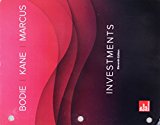
GEN COMBO LOOSELEAF INVESTMENTS; CONNECT ACCESS CARD
11th Edition
ISBN: 9781260201550
Author: Bodie
Publisher: MCG
expand_more
expand_more
format_list_bulleted
Question
Chapter 24, Problem 12CP
A
Summary Introduction
To explain: Market index, benchmark, and median of the portfolio.
Introduction: Market index judge the performance of portfolio, benchmark also maintain the performance and manger universe monitor the performance of manager.
B
Summary Introduction
To explain: Sharpe ratio, Treynor ratio, and Alpha value for the portfolio.
Introduction: Sharpe ratio is measured with respect to the standard deviation, Treynor ratio is measured with respect to beta value and Alpha value is difference of returns.
Expert Solution & Answer
Want to see the full answer?
Check out a sample textbook solution
Students have asked these similar questions
Cost of Trade Credit
A large retailer obtains merchandise under the credit terms of 3/20, net 35, but routinely takes 65 days to pay its bills. (Because the retailer is an important customer, suppliers allow the firm to stretch its credit terms.) What is the retailer's effective cost of trade credit? Assume a 365-day year. Do not round intermediate calculations. Round your answer to two decimal places. The answer is not 27.09 which is incorrect.
You invest $1,000 a year for 10 years at 6 percent and then invest $2,000 a year for an additional 10 years at 6 percent. How much will you have accumulated at the end of the 20 years?
Answer: $49,967
*Please include all work & formulas
No ai please!
What is the role of an underwriter in an IPO?A) To lend money to the companyB) To set the dividend policyC) To buy the securities and sell them to the publicD) To manage the company’s operations
need he
Chapter 24 Solutions
GEN COMBO LOOSELEAF INVESTMENTS; CONNECT ACCESS CARD
Ch. 24 - Prob. 1PSCh. 24 - Prob. 2PSCh. 24 - Prob. 3PSCh. 24 - Prob. 4PSCh. 24 - Prob. 5PSCh. 24 - Prob. 6PSCh. 24 - Prob. 7PSCh. 24 - Prob. 8PSCh. 24 - Prob. 9PSCh. 24 - Prob. 10PS
Ch. 24 - Prob. 11PSCh. 24 - Prob. 12PSCh. 24 - Prob. 13PSCh. 24 - Prob. 14PSCh. 24 - Prob. 15PSCh. 24 - Prob. 16PSCh. 24 - Prob. 17PSCh. 24 - Prob. 18PSCh. 24 - Prob. 19PSCh. 24 - Prob. 20PSCh. 24 - Prob. 21PSCh. 24 - Prob. 22PSCh. 24 - Prob. 1CPCh. 24 - Prob. 2CPCh. 24 - Prob. 3CPCh. 24 - Prob. 4CPCh. 24 - Prob. 5CPCh. 24 - Prob. 6CPCh. 24 - Prob. 7CPCh. 24 - Prob. 8CPCh. 24 - Prob. 9CPCh. 24 - Prob. 10CPCh. 24 - Prob. 11CPCh. 24 - Prob. 12CPCh. 24 - Prob. 13CPCh. 24 - Prob. 14CP
Knowledge Booster
Similar questions
- No ai tool What is the role of an underwriter in an IPO?A) To lend money to the companyB) To set the dividend policyC) To buy the securities and sell them to the publicD) To manage the company’s operationsarrow_forwardWhich of the following is a money market instrument?A) Treasury bondsB) Corporate bondsC) Commercial paperD) Common stock need help!!arrow_forwardFinance Subject.Which of the following is a money market instrument?A) Treasury bondsB) Corporate bondsC) Commercial paperD) Common stockarrow_forward
- Help please without use of AI. no What is the main purpose of financial ratios?A) To guarantee a company's profitabilityB) To evaluate a company's financial performance and healthC) To increase a company's stock priceD) To ensure a company's debts are eliminatedarrow_forwardPlease don't use ai tool If a stock’s beta is 1.5, what does this indicate?A) The stock is less volatile than the marketB) The stock is more volatile than the marketC) The stock is not correlated with the market D) The stock is risk-freearrow_forwardNo ai What is the primary function of a financial market?A) To set interest ratesB) To facilitate the transfer of funds between savers and borrowersC) To regulate the banking industryD) To manage the government’s budgetarrow_forward
- no What is the main purpose of financial ratios?A) To guarantee a company's profitabilityB) To evaluate a company's financial performance and healthC) To increase a company's stock priceD) To ensure a company's debts are eliminatedarrow_forwardplease don't use chatgpt What happens to the value of money when inflation increases?A) The value of money increasesB) The value of money decreasesC) The value of money remains unchangedD) The value of money fluctuates randomly helparrow_forwardDo not use Ai tool What happens to the value of money when inflation increases?A) The value of money increasesB) The value of money decreasesC) The value of money remains unchangedD) The value of money fluctuates randomlyarrow_forward
- No AI tool. Which of the following best defines a bond's coupon rate?A) The market rate of interest on the bondB) The annual interest payment as a percentage of the bond's face valueC) The difference between the bond's face value and its market priceD) The total return from holding the bond to maturityarrow_forwardNo ai!! answer it A portfolio's risk can be reduced by: A) Investing in a single stock B) Diversifying investments across different asset classes C) Borrowing money to invest more D) Only investing in high-risk assets need help.arrow_forwardNo chatgpt! A portfolio's risk can be reduced by: A) Investing in a single stock B) Diversifying investments across different asset classes C) Borrowing money to invest more D) Only investing in high-risk assets need help!arrow_forward
arrow_back_ios
SEE MORE QUESTIONS
arrow_forward_ios
Recommended textbooks for you
 Auditing: A Risk Based-Approach (MindTap Course L...AccountingISBN:9781337619455Author:Karla M Johnstone, Audrey A. Gramling, Larry E. RittenbergPublisher:Cengage Learning
Auditing: A Risk Based-Approach (MindTap Course L...AccountingISBN:9781337619455Author:Karla M Johnstone, Audrey A. Gramling, Larry E. RittenbergPublisher:Cengage Learning


Auditing: A Risk Based-Approach (MindTap Course L...
Accounting
ISBN:9781337619455
Author:Karla M Johnstone, Audrey A. Gramling, Larry E. Rittenberg
Publisher:Cengage Learning